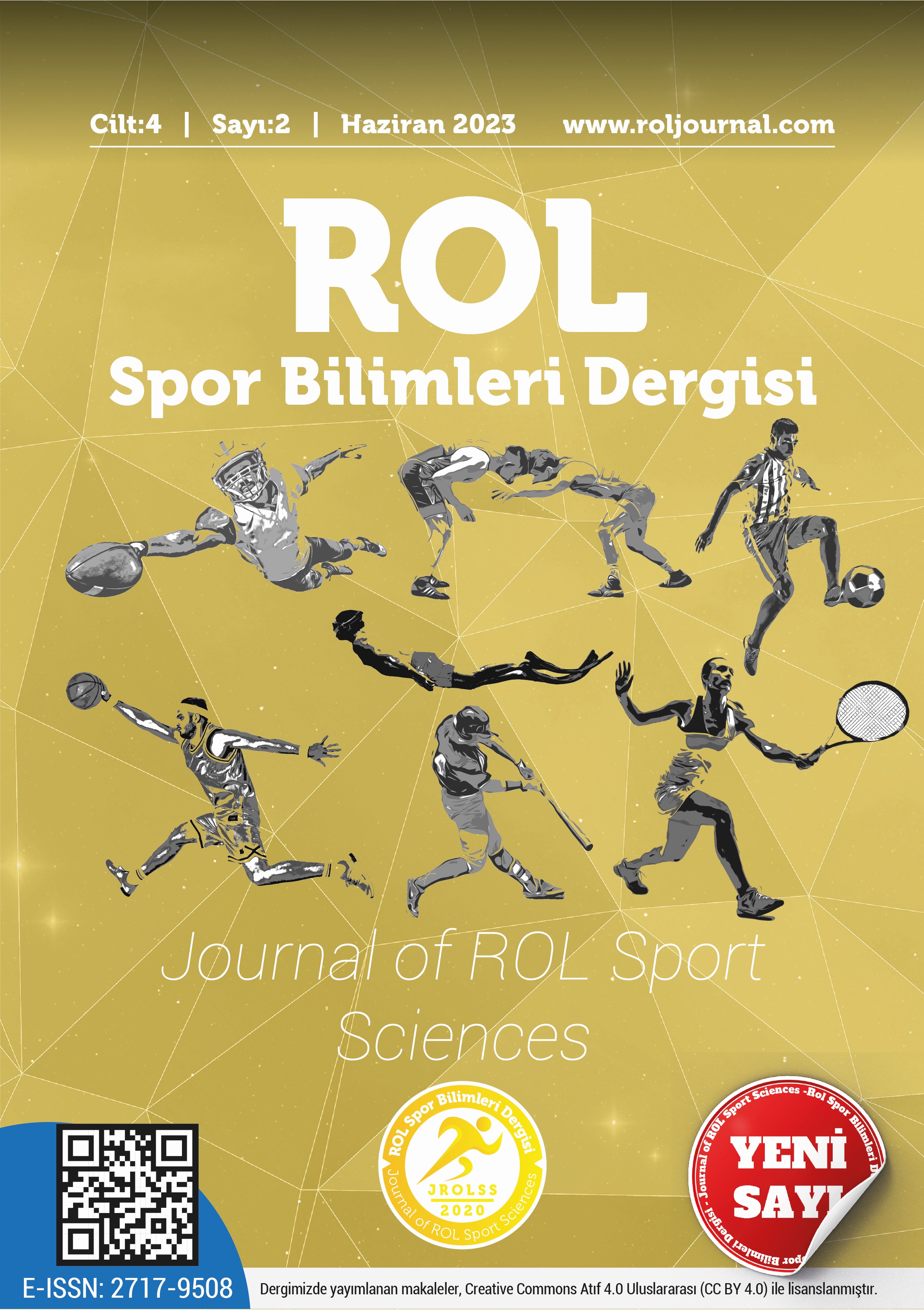Sağlıklı yetişkinlerde Spinning® seansının vücut kompozisyonu üzerindeki akut etkileri
DOI:
https://doi.org/10.5281/zenodo.8021376Anahtar Kelimeler:
Fiziksel aktivite, kas kütlesi, kapalı alan bisiklet, vücut yağıÖzet
Bu çalışmanın amacı, sağlıklı yetişkinlerde Spinning® seansının vücut kompozisyonu üzerindeki akut etkilerini belirlemektir. Çalışmaya 32 sağlıklı yetişkin (9 erkek, 23 kadın) gönüllü olarak katıldı. Katılımcıların vücut kompozisyonları Spinning® seansı öncesi ve sonrasında biyoelektrik empedans analizi (BIA) ile belirlendi. Spinning® seansı sonrası kadınlarda vücut kütlesi, vücut yağı, visseral yağ seviyesi ve metabolik yaşta anlamlı bir azalma ve toplam vücut suyu, kas kütlesi, bazal metabolizma hızı, fiziksel aktivite seviyesinde anlamlı bir artış belirlendi. Spinning® seansından sonra erkeklerde vücut kütlesi, vücut yağı, iç organ yağ seviyesinde anlamlı bir azalma ve toplam vücut suyu, kas kütlesi, bazal metabolizma hızında anlamlı bir artış bulundu. Erkeklerde Spinning® seansı sonrası metabolik yaştaki düşüş ve fiziksel aktivite düzeyindeki artışa rağmen bu fark anlamlı değildi. Spinning® egzersizi, sağlıklı yetişkinlerde vücut kompozisyonu üzerinde anlamlı bir akut etkiye sahiptir. Sonuç olarak Spinning®, hem tek seansta bile vücut kompozisyonu üzerindeki etkileri hem de sağlıklı yetişkinler için eğlenceli bir fiziksel aktivite olması nedeniyle sedanter bireyler için uzun süreli yararlı etkilere sahip alternatif bir fiziksel aktivite olarak önerilebilir.
Referanslar
ACSM. (2000). American college of sports medicine: guidelines for exercise testing and prescription. Lippincott Williams & Wilkins.
Arija, V., Villalobos, F., Pedret, R., Vinuesa, A., Jovani, D., & Pascual, G., (2018). Physical activity, cardiovascular health , quality of life and blood pressure control in hypertensive subjects: Randomized clinical trial. Health and Quality of Life Outcomes, (16), 1–11.
Barbado, C., Foster, C., Vicente-Campos, D., & Lopez-Chicharro, J. (2017). Exercise intensity during indoor cycling. International Journal of Medicine and Sciences of Physical Activity and Sport, 17(67), 481–491.
Battista, R. A., Foster, C., Andrew, J., Wright, G., Lucia, A., & Porcari, J. P. (2008). Physiologic responses during indoor cycling. Journal of Strength and Conditioning Research, 22(4), 1236–1241.
Bianco, A., Bellafiore, M., Battaglia, G., Paoli, A., Caramazza, G., Farina, F., ... et al. (2010). The effects of indoor cycling training in sedentary overweight women. Journal of Sports Medicine and Physical Fitness, 50(2), 159–165.
Caria, M. A., Tangianu, F., Concu, A., Crisafulli, A., & Mameli, O. (2007). Quantification of Spinning® bike performance during a standard 50-minute class. Journal of Sports Science, 25(2), 421–429.
Chavarrias, M., Carlos-Vivas, J., Collado-Mateo, D., & Perez-Gomez, J. (2019). Health benefits of indoor cycling: a systematic review. Medicina, (55), 1–14.
Cohen, J. (2013). Statistical power analysis for the behavioral sciences, Routledge.
Chukhlantseva, N. (2019). Effectiveness of an indoor cycling program in improving the physical condition of young women. Polish Journal of Sport and Tourism, 26(3), 14–19.
Francis, P. R., Witucki, A. S., & Buono, M. J. (1999). Physiological response to a typical studio cycling session. ACSM’S Health & Fitness Journal, 3(1), 30–36.
Heymsfield, S.B. (2004). Algorithm development for estimating visceral fat rating. tanita ınstitute contract study, Columbia University College of Physicians and Surgeons.
Kaya, F., Nar, D., & Erzeybek, M. S. (2018). Effect of spinning cycling training on body composition in women. Journal of Education and Training Studies, 6(4), 154–160.
Lazar-Ivkoviç, T. (2005). The place and role of physical activity in the treatment of obesity. Medicinski Pregled, 58, 85–87.
López-Miñarro, P. A., & Muyor, J. M. (2010). Heart rate and overall ratings of perceived exertion during Spinning® cycle indoor session in novice adults. Science & Sports, 25(5), 238–244.
Masuda, Y., Wam, R., Paik, B., Ngoh, C., Choog, M. A., & Ng, J. J. (2022). Clinical characteristics and outcomes of exertional rhabdomyolysis after indoor spinning: A systematic review. The Physician and Sportsmedicine, 1–12.
Nordengen, S., Andersen, L. B., Solbraa, A. K., & Riiser, A. (2019). Cycling and cardiovascular disease risk factors including body composition, blood lipids and cardiorespiratory fitness analysed as continuous variables: Part 2—systematic review with meta-analysis. British Journal of Sports Medicine, 53, 879–885.
Pang, Y., Kartsonaki, C., Du, H., Millwood, I. Y., Guo, Y., Chen, Y., … et al. (2019). Physical activity, sedentary leisure time, circulating metabolic markers, and risk of major vascular diseases. Circulation: Genomic and Precision Medicine, 12.
Pietrobelli, A., Rubiano, F., St-Onge, M. P., & Heymsfield, S. B. (2004). New bioimpedance analysis system: improved phenotyping with whole-body analysis. European Journal of Clinical Nutrition, 58(11), 1479-1484.
Pietrobelli, A., Rubiano, F., St-Onge, M. P., & Heymsfield, S. B. (2004). New bioimpedance analysis system: improved phenotyping with whole-body analysis. European Journal of Clinical Nutrition, 58(11), 1479-1484.
Ratajczak, M., Skrypnik, D., Krutki, P., & Karolkiewicz, J. (2020). Effects of an indoor cycling program on cardiometabolic factors in women with obesity vs. normal body weight. International Journal of Environmental Research and Public Health, 17(3), 8718.
Santos, R. M., Costa, F. C., Saralva, T. S., & Callegari, B. (2017). Muscle fatigue in participants of indoor cycling. Muscles, Ligaments and Tendons Journal, 7(1), 173–179.
Stutts, W. C. (2002). Physical activity determinants in adults: perceived benefits, barriers, and self efficacy. Aaohn Journal, 50(11), 499–507.
Szabo, A., Gáspár, Z., Kiss, N., & Radványi, A. (2015). Effect of spinning workouts on affect. Journal of Mental Health, 24(3), 145–149.
Thompson, W. R. (2019). Worldwide survey of fitness trends for 2020. ACSMs Health & Fitness Journal, 23(6), 10–18.
Valle, S. V, Mello, D. B., Fortes, M. S. R., Dantas, E. H. M. D., & Mattos, M. A. (2010). Effect of diet and indoor cycling on body composition and serum lipid. Arquivos Brasileiros de Cardiologia, 95(2), 173–178.
Verrusio, W., Andreozzi, P., Renzi, A., Martinez, A., Longo, G., Musumeci, M., ... et al. (2016). Efficacy and safety of spinning exercise in middle-aged and older adults with metabolic syndrome: randomized control trial. Annali Dell’Istituto Superiore Di Sanità, 52(2), 295–300.
Yoon, J. G., Kim, S. H., & Rhyu, H. S. (2017). Effects of 16-week spinning and bicycle exercise on body composition, physical fitness and blood variables of middle school students. Journal of Exercise Rehabilitation, 13(4), 400–404.
İndir
Yayınlanmış
Nasıl Atıf Yapılır
Sayı
Bölüm
Lisans
Telif Hakkı (c) 2023 ROL Spor Bilimleri Dergisi

Bu çalışma Creative Commons Attribution 4.0 International License ile lisanslanmıştır.


